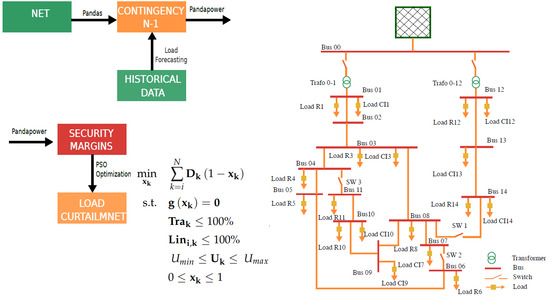Load Curtailment Optimization Using the PSO Algorithm for Enhancing the Reliability of Distribution Networks
Abstract
1. Introduction
- A Fourier series is used to fit the load forecast hourly and during the week days;
- A simple formulation to optimize load curtailment during contingencies is proposed in order to enhance the reliability of conventional distribution systems;
- A practical implementation taking into account the conventional operator resources with limited information is suggested.
2. Background
2.1. Load Curtailment Methods
2.2. Particle Swarm Optimization Algorithm
- Establish the number of individuals in the swarm. Each individual must have information on its position, value, speed, where it is traveling to, and a record of the best position where it has been;
- Evaluate each individual or particle with the objective function;
- Update the position and speed of each particle;
- If the results do not comply with the optimization criteria established in the objective function and its restrictions, return to step 2 cyclically until convergenced is achieved.
2.3. Reliability Index SAIDI
3. Proposed Procedure for Load Shedding Optimization
4. Load Shedding Algorithm Assessment
4.1. Simulation Description
4.2. Simulation Results
4.3. Simulation Results Assessment
4.4. Scalability of the Proposed Method
5. Conclusions
Author Contributions
Funding
Conflicts of Interest
References
- Lacommare, K.H.; Berkeley, L.; Eto, J.H.; Berkeley, L. Distinguishing Among the Sources of Electric Service Interruptions. In Proceedings of the 2018 IEEE International Conference on Probabilistic Methods Applied to Power Systems (PMAPS), Boise, ID, USA, 24–28 June 2018; pp. 1–6. [Google Scholar] [CrossRef]
- Liu, Y.; Fan, R.; Terzija, V. Power system restoration: A literature review from 2006 to 2016. J. Mod. Power Syst. Clean Energy 2016, 4, 332–341. [Google Scholar] [CrossRef]
- Mohaghar, A.; Shahriari, S.; Hasani, B. A New Mathematical Model of Optimization Load Shedding in Distribution Systems to Achieve Strategic Objectives of Electricity Demand Side Management. Technical Report 2. Glob. J. Manag. Stud. Res. 2015, 2, 132–141. [Google Scholar]
- The Essential Services Commission of South Australia. Electricity Distribution Code; Government Administration Adelaide: Adelaide, Australia, 2015.
- Power Networks, U. Guaranteed Standards of Performance for Metered Demand Customers of Electricity Distribution Companies in England, Wales & Scotland; Wales & Scotland Office of Gas and Electricity Markets (OFGEM): London, UK, 2013; pp. 1–7.
- Certification, R.C.; Standards, E.R.; Prefix, N.D.; Filed, P.; Corp, R.; Standards, M.R. NERC Full Notice of Penalty Regarding Avangrid; North American Reliability Corporation: Washington, DC, USA, 2019; Volume 7. [Google Scholar]
- Pollitt, M.G. The European Single Market in Electricity: An Economic Assessment. Rev. Ind. Organ. 2019, 55, 63–87. [Google Scholar] [CrossRef]
- Mohiti, M.; Monsef, H.; Anvari-Moghaddam, A.; Lesani, H. Two-Stage Robust Optimization for Resilient Operation of Microgrids Considering Hierarchical Frequency Control Structure. IEEE Trans. Ind. Electron. 2019, 1. [Google Scholar] [CrossRef]
- Calderaro, V.; Galdi, V.; Graber, G.; Piccolo, A. Generation Rescheduling and Load Shedding in Distribution Systems Under Imprecise Information. IEEE Syst. J. 2018, 12, 383–391. [Google Scholar] [CrossRef]
- Vahedipour-Dahraie, M.; Anvari-Moghaddam, A.; Guerrero, J.M. Evaluation of reliability in risk-constrained scheduling of autonomous microgrids with demand response and renewable resources. IET Renew. Power Gener. 2018, 12, 657–667. [Google Scholar] [CrossRef]
- Stochastic Risk-Constrained Scheduling of Renewable-Powered Autonomous Microgrids With Demand Response Actions: Reliability and Economic Implications. IEEE Trans. Ind. Appl. 2020, 56, 1882–1895. [CrossRef]
- Alqunun, K.; Guesmi, T.; Farah, A. Load shedding optimization for economic operation cost in a microgrid. Electr. Eng. 2020. [Google Scholar] [CrossRef]
- Evangelopoulos, V.A.; Georgilakis, P.S.; Hatziargyriou, N.D. Optimal operation of smart distribution networks: A review of models, methods and future research. Electr. Power Syst. Res. 2016, 140, 95–106. [Google Scholar] [CrossRef]
- Vargas, A.; Saavedra, O.R.; Samper, M.E.; Rivera, S.; Rodriguez, R. Latin American Energy Markets: Investment Opportunities in Nonconventional Renewables. IEEE Power Energy Mag. 2016, 14, 38–47. [Google Scholar] [CrossRef]
- Soares, J.; Lobo, C.; Silva, M.; Morais, H.; Vale, Z. Relaxation of non-convex problem as an initial solution of meta-heuristics for energy resource management. In Proceedings of the 2015 IEEE Power Energy Society General Meeting, Denver, CO, USA, 26–30 July 2015; pp. 1–5. [Google Scholar]
- Asrari, A.; Ansari, M.; Bibek, K.C. Real-time Congestion Prevention in Modern Distribution Power Systems via Demand Response of Smart Homes. In Proceedings of the 2019 North American Power Symposium (NAPS), Wichita, KS, USA, 13–15 October 2019; pp. 1–6. [Google Scholar]
- Lou, X.; Yau, D.K.Y.; Nguyen, H.H.; Chen, B. Profit-Optimal and Stability-Aware Load Curtailment in Smart Grids. IEEE Trans. Smart Grid 2013, 4, 1411–1420. [Google Scholar] [CrossRef]
- Jianjun, F.A.Z.; Dong, S.B.Z.; Yang, G.; Zhihong, T.C.Y. Load Shedding control Strategy for power system Based on the system frequency and voltage stability (Apr 2018). In Proceedings of the 2018 China International Conference on Electricity Distribution, Tianjin, China, 17–19 September 2018; pp. 17–19. [Google Scholar]
- Xie, J.; Liu, C.C.; Sforna, M.; Xu, Y. Consensus weighting of a multi-agent system for load shedding. Int. J. Electr. Power Energy Syst. 2020, 117, 105615. [Google Scholar] [CrossRef]
- Verayiah, R.; Mohamed, A.; Shareef, H.; Abidin, I.Z. Under Voltage Load Shedding Scheme Using Meta-heuristic Optimization Methods. Prz. Elektrotechniczny 2014. [Google Scholar] [CrossRef]
- Raghu, C.N.; Manjunatha, A. Assessing Effectiveness of Research for Load Shedding in Power System. Int. J. Electr. Comput. Eng. (IJECE) 2017, 7, 3235–3245. [Google Scholar] [CrossRef]
- Gao, H.; Chen, Y.; Xu, Y.; Liu, C.C. Dynamic load shedding for an islanded microgrid with limited generation resources. IET Gener. Transm. Distrib. 2016, 10, 2953–2961. [Google Scholar] [CrossRef]
- Awad, A.S.A.; EL-Fouly, T.H.M.; Salama, M.M.A. Optimal ESS Allocation and Load Shedding for Improving Distribution System Reliability. IEEE Trans. Smart Grid 2014, 5, 2339–2349. [Google Scholar] [CrossRef]
- Nourollah, S.; Aminifar, F.; Gharehpetian, G.B. A Hierarchical Regionalization-Based Load Shedding Plan to Recover Frequency and Voltage in Microgrid. IEEE Trans. Smart Grid 2019, 10, 3818–3827. [Google Scholar] [CrossRef]
- Dreidy, M.; Mokhlis, H.; Mekhilef, S. Application of meta-heuristic techniques for optimal load shedding in islanded distribution network with high penetration of solar PV generation. Energies 2017, 10, 150. [Google Scholar] [CrossRef]
- Application of hybrid meta-heuristic techniques for optimal load shedding planning and operation in an islanded distribution network integrated with distributed generation. Energies 2018, 11, 1134. [CrossRef]
- Narayanan, K.; Siddiqui, S.A.; Fozdar, M. Hybrid islanding detection method and priority-based load shedding for distribution networks in the presence of DG units. IET Gener. Transm. Distrib. 2017, 11, 586–595. [Google Scholar] [CrossRef]
- Kennedy, J.; Eberhart, R. Particle Swarm Optimization. In Proceedings of the ICNN’95—International Conference on Neural Networks, Perth, WA, Australia, 27 November–1 December 1995; pp. 1942–1948. [Google Scholar]
- Sanchez, A.; Romero, A.; Rattá, G.; Rivera, S. Smart charging of PEVs to reduce the power transformer loss of life. In Proceedings of the 2017 IEEE PES Innovative Smart Grid Technologies Conference—Latin America (ISGT Latin America), Quito, Ecuador, 20–22 September 2017; pp. 1–6. [Google Scholar]
- Sengupta, S.; Basak, S.; Alan, R.; Ii, P. Particle Swarm Optimization: A Survey of Historical and Recent Developments with Hybridization Perspectives. Mach. Learn. Knowl. Extr. 2018, 1, 10. [Google Scholar] [CrossRef]
- Poli, R. An Analysis of Publications on Particle Swarm Optimisation Applications. J. Artif. Evol. Appl. 2014, 1–10. [Google Scholar] [CrossRef]
- Society, I.P.E. IEEE Std 1366™-2003: IEEE Guide for Electric Power Distribution Reliability Indices; IEEE: Piscataway, NJ, USA, 2004. [Google Scholar]
- Cruz, L.M.; Alvarez, D.L.; Rivera, S.R.; Herrera, F.A. Short-Term Demand Forecast Using Fourier Series. In Proceedings of the 2019 IEEE Workshop on Power Electronics and Power Quality Applications (PEPQA), Manizales, Colombia, 30–31 May 2019; pp. 1–5. [Google Scholar]
- Thurner, L.; Scheidler, A.; Sch, F.; Menke, J.H.; Dollichon, J.; Meier, F.; Meinecke, S.; Braun, M. Pandapower—An Open-Source Python Tool for Convenient Modeling, Analysis, and Optimization of Electric Power Systems. IEEE Trans. Power Syst. 2018, 33, 6510–6521. [Google Scholar] [CrossRef]
- Conseil International des Grands réseaux électriques. Comité d’études C6. Benchmark Systems for Network Integration of Renewable and Distributed Energy Resources: Task Force C6.04; [Brochures thématiques]; CIGRE: Paris, France, 2014. [Google Scholar]
- Tonda, A. Inspyred: Bio-inspired algorithms in Python. Genet. Program. Evolvable Mach. 2020, 21, 269–272. [Google Scholar] [CrossRef]
- Wang, Y.; Zhao, T.; Ju, C.; Xu, Y.; Wang, P. Two-Level Distributed Voltage /Var Control using Aggregated PV Inverters in Distribution Network s. IEEE Trans. Power Deliv. 2019, 1. [Google Scholar] [CrossRef]
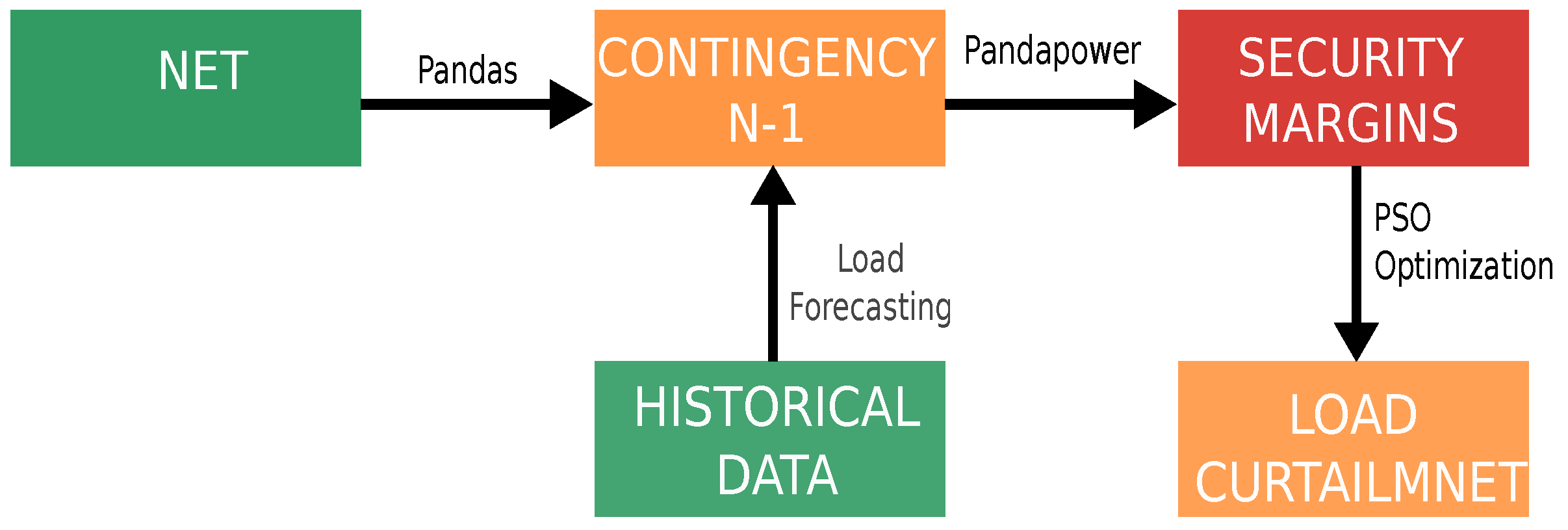
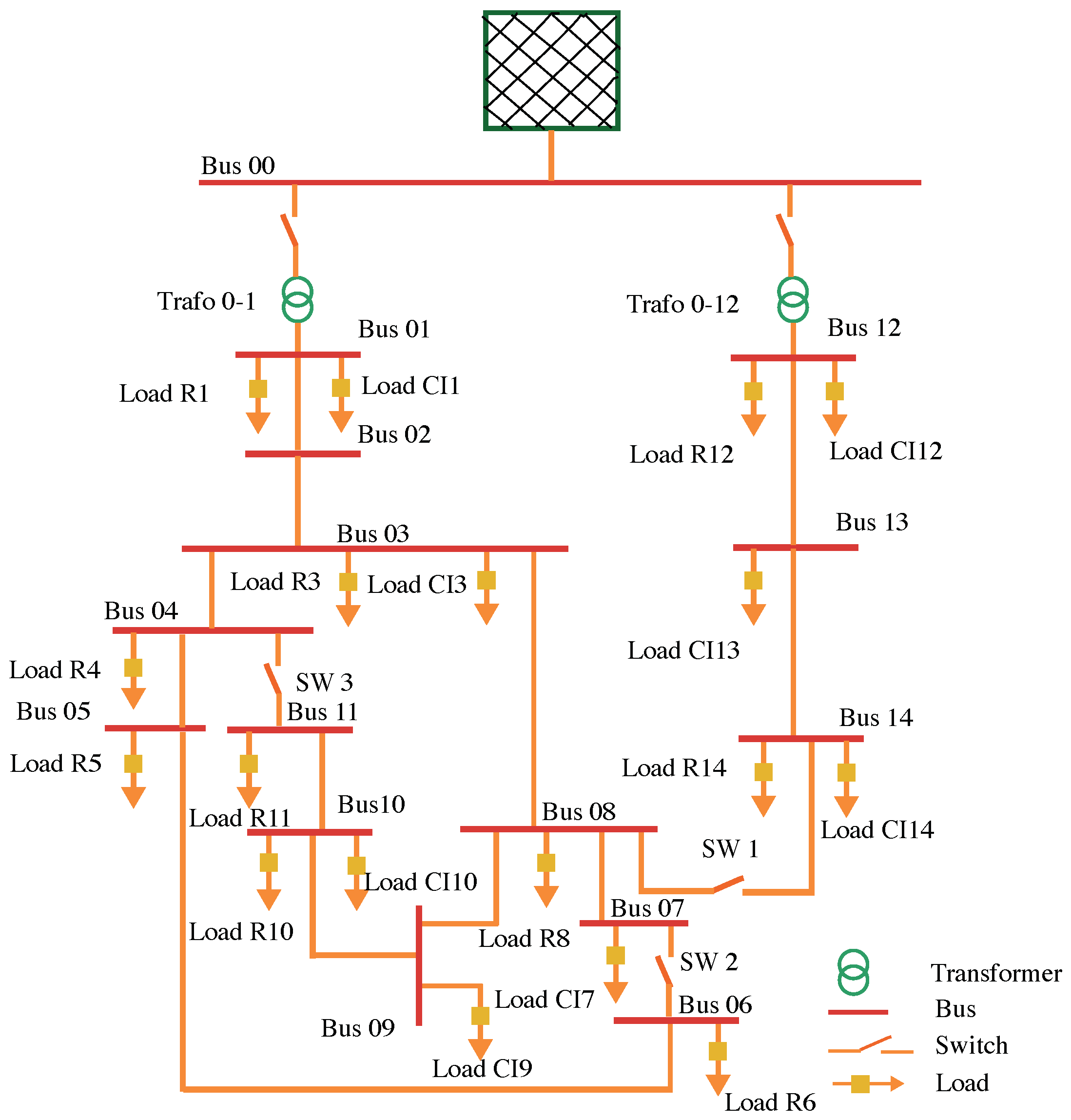
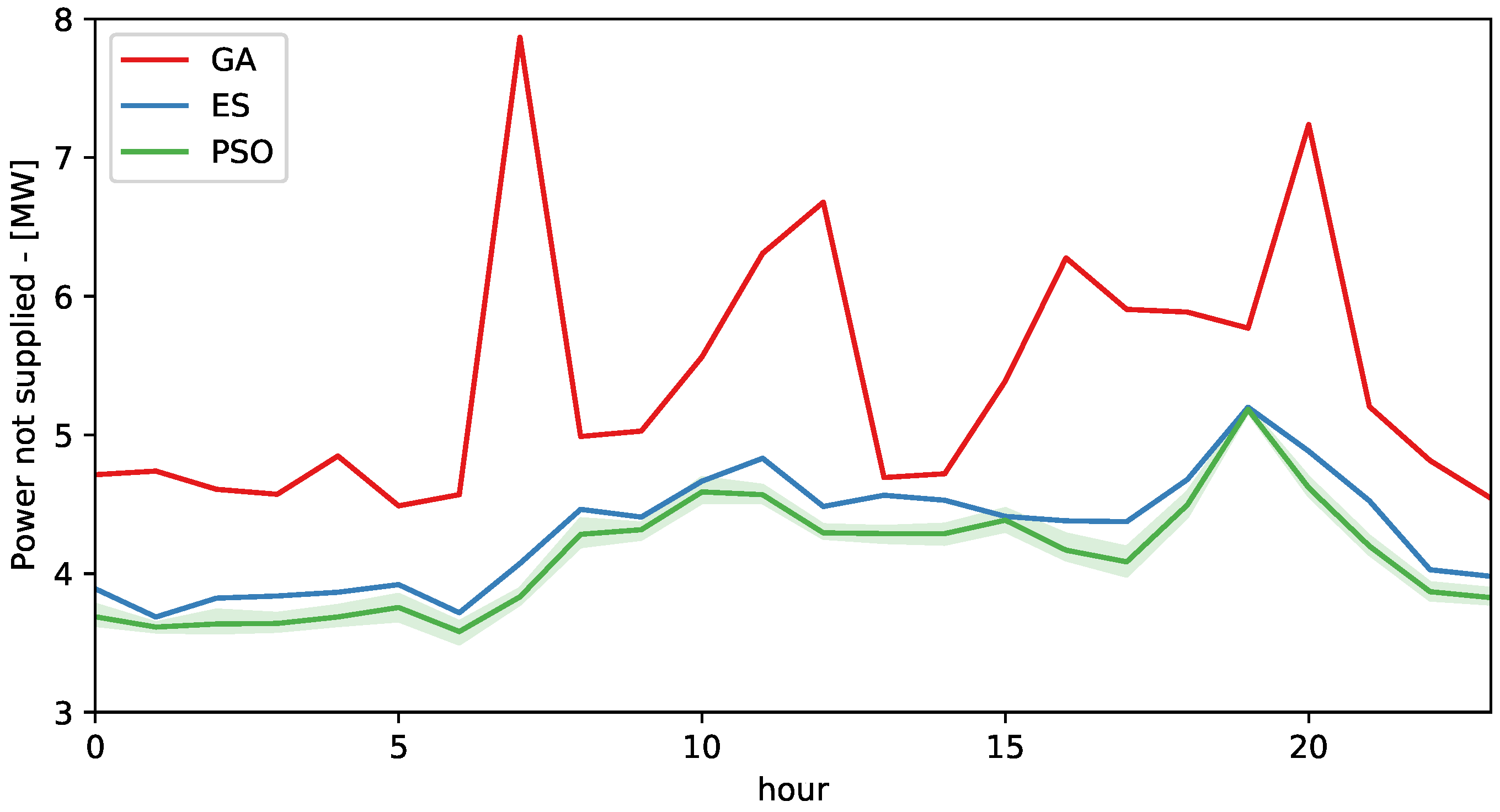

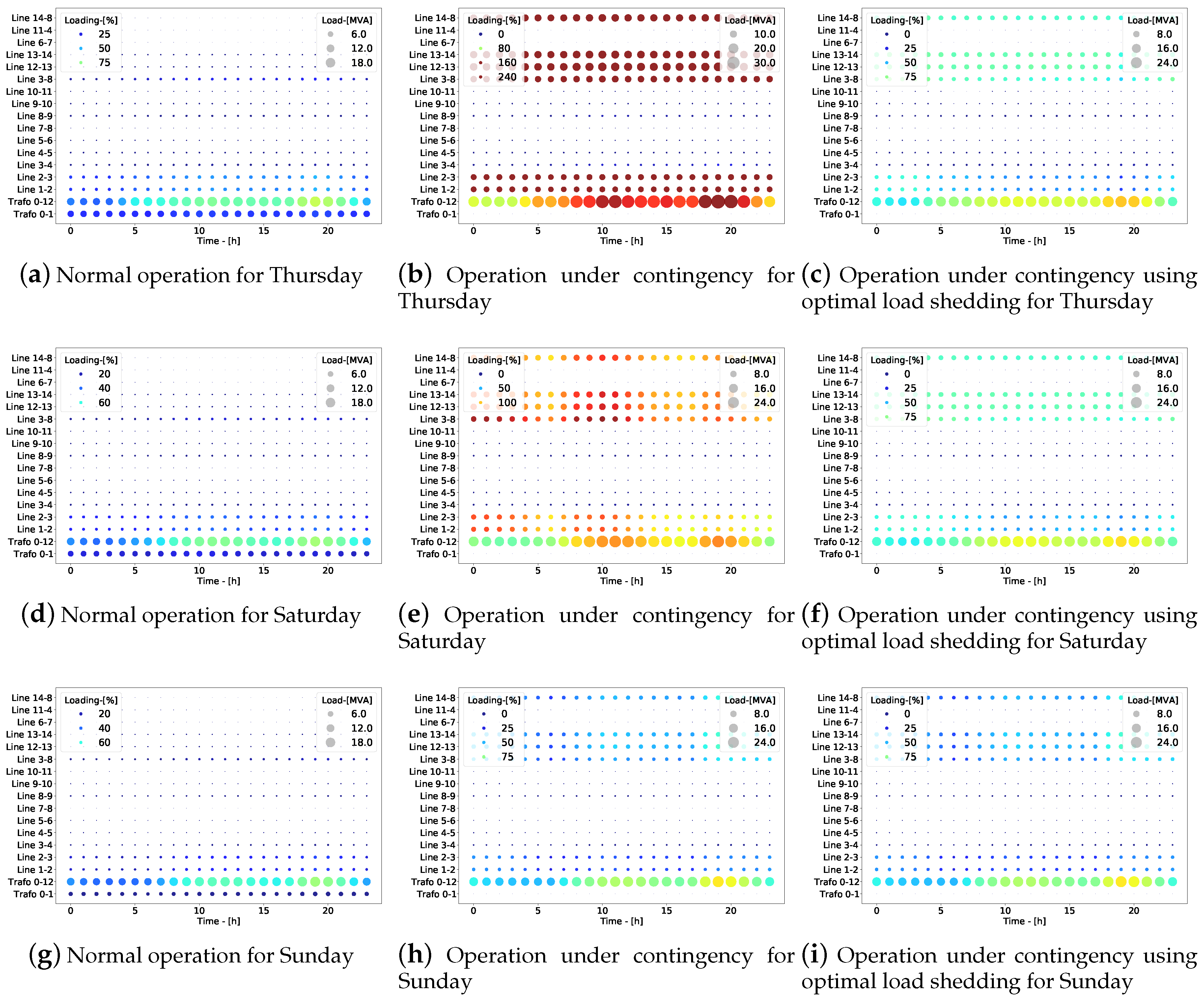
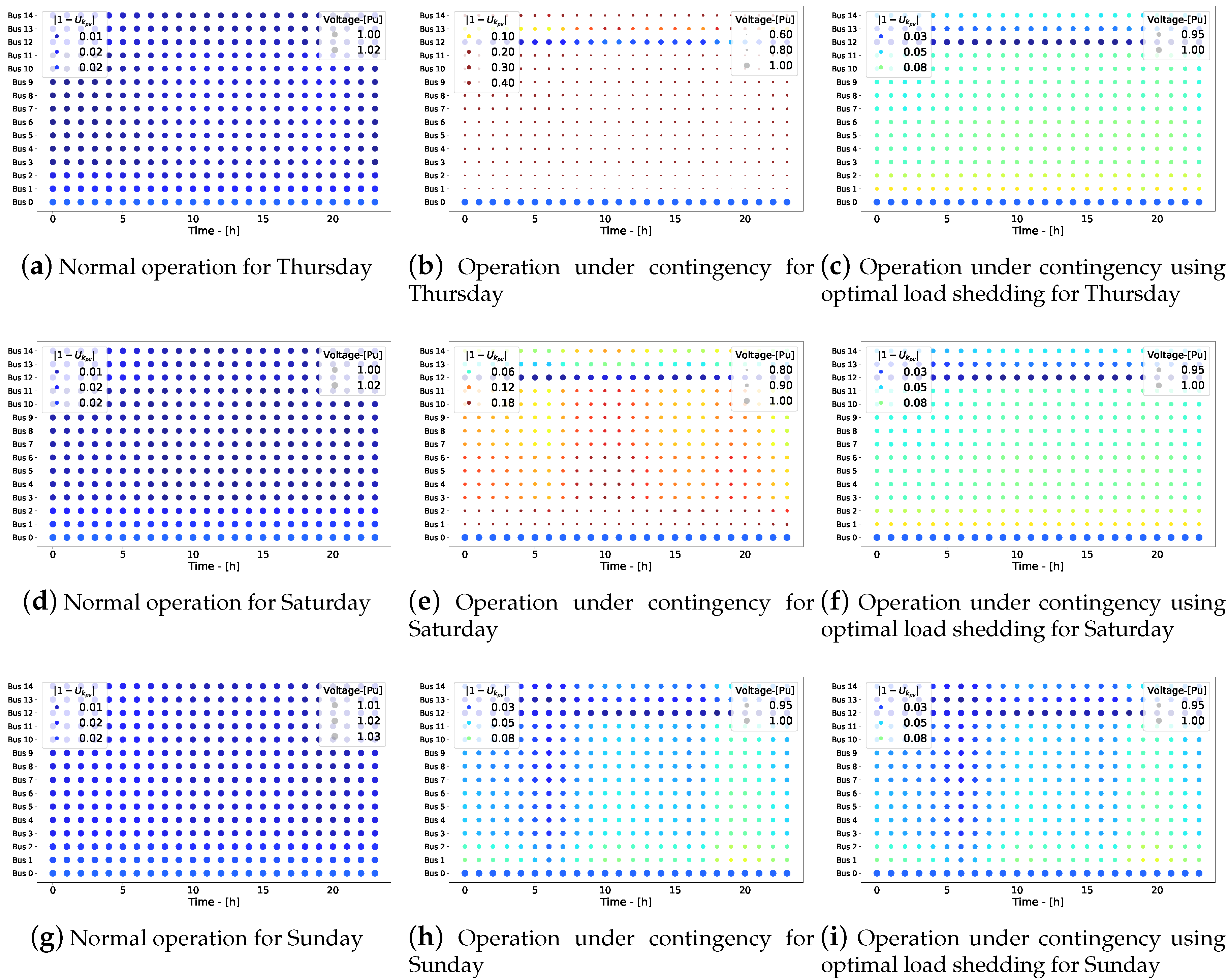

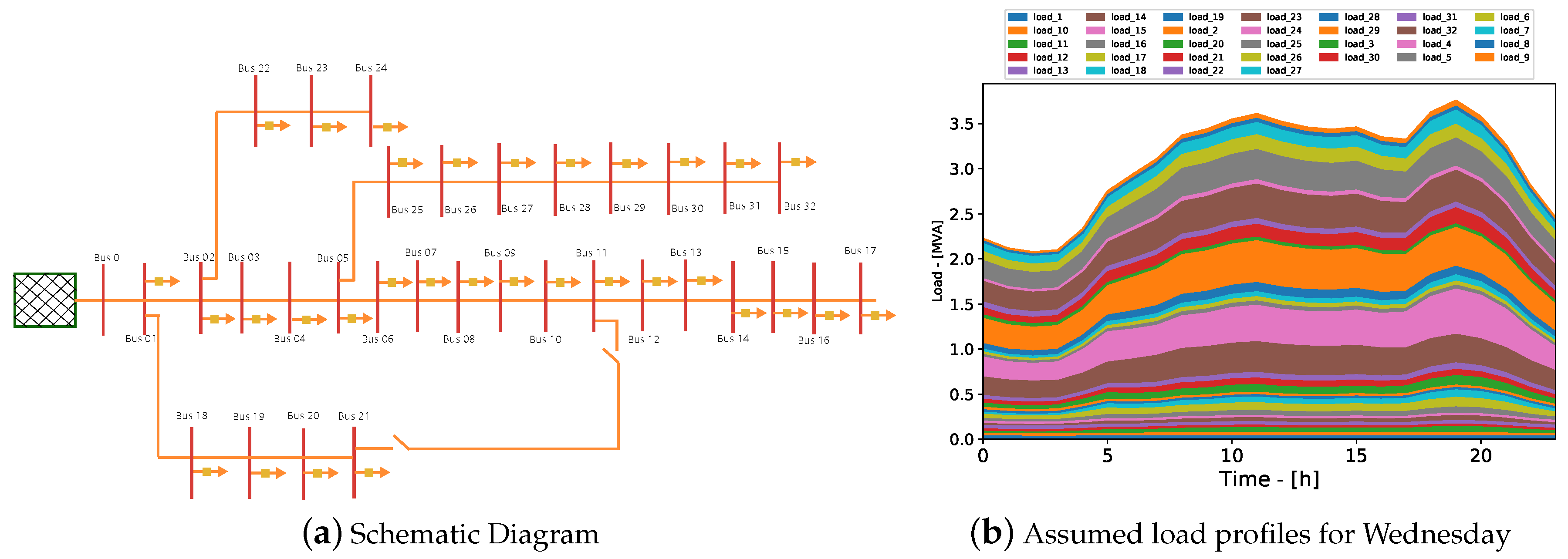


| Conventional Method (Opening SW1) | Proposed Load Curtailment | |||
|---|---|---|---|---|
| Weekdays | -() | EENS-() | -() | EENS-() |
| Monday | 6.82 | 137.7 | 1.87 | 40.2 |
| Tuesday | 8.14 | 179.5 | 3.63 | 81.0 |
| Wednesday | 8.04 | 176.1 | 3.52 | 77.8 |
| Thursday | 8.39 | 199.8 | 4.24 | 101.6 |
| Friday | 7.63 | 170.9 | 3.22 | 73.0 |
| Saturday | 6.89 | 144.2 | 2.23 | 47.0 |
| Sunday | 4.43 | 75.6 | 0.01 | 0.1 |
| Mean | 7.2 | 154.8 | 2.7 | 60.1 |
© 2020 by the authors. Licensee MDPI, Basel, Switzerland. This article is an open access article distributed under the terms and conditions of the Creative Commons Attribution (CC BY) license (http://creativecommons.org/licenses/by/4.0/).
Share and Cite
Cruz, L.M.; Alvarez, D.L.; Al-Sumaiti, A.S.; Rivera, S. Load Curtailment Optimization Using the PSO Algorithm for Enhancing the Reliability of Distribution Networks. Energies 2020, 13, 3236. https://doi.org/10.3390/en13123236
Cruz LM, Alvarez DL, Al-Sumaiti AS, Rivera S. Load Curtailment Optimization Using the PSO Algorithm for Enhancing the Reliability of Distribution Networks. Energies. 2020; 13(12):3236. https://doi.org/10.3390/en13123236
Chicago/Turabian StyleCruz, Laura M., David L. Alvarez, Ameena S. Al-Sumaiti, and Sergio Rivera. 2020. "Load Curtailment Optimization Using the PSO Algorithm for Enhancing the Reliability of Distribution Networks" Energies 13, no. 12: 3236. https://doi.org/10.3390/en13123236
APA StyleCruz, L. M., Alvarez, D. L., Al-Sumaiti, A. S., & Rivera, S. (2020). Load Curtailment Optimization Using the PSO Algorithm for Enhancing the Reliability of Distribution Networks. Energies, 13(12), 3236. https://doi.org/10.3390/en13123236




